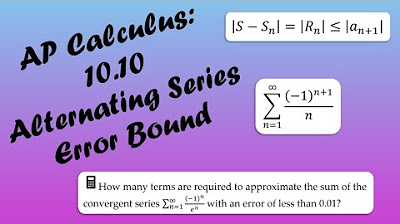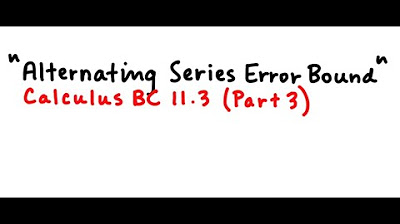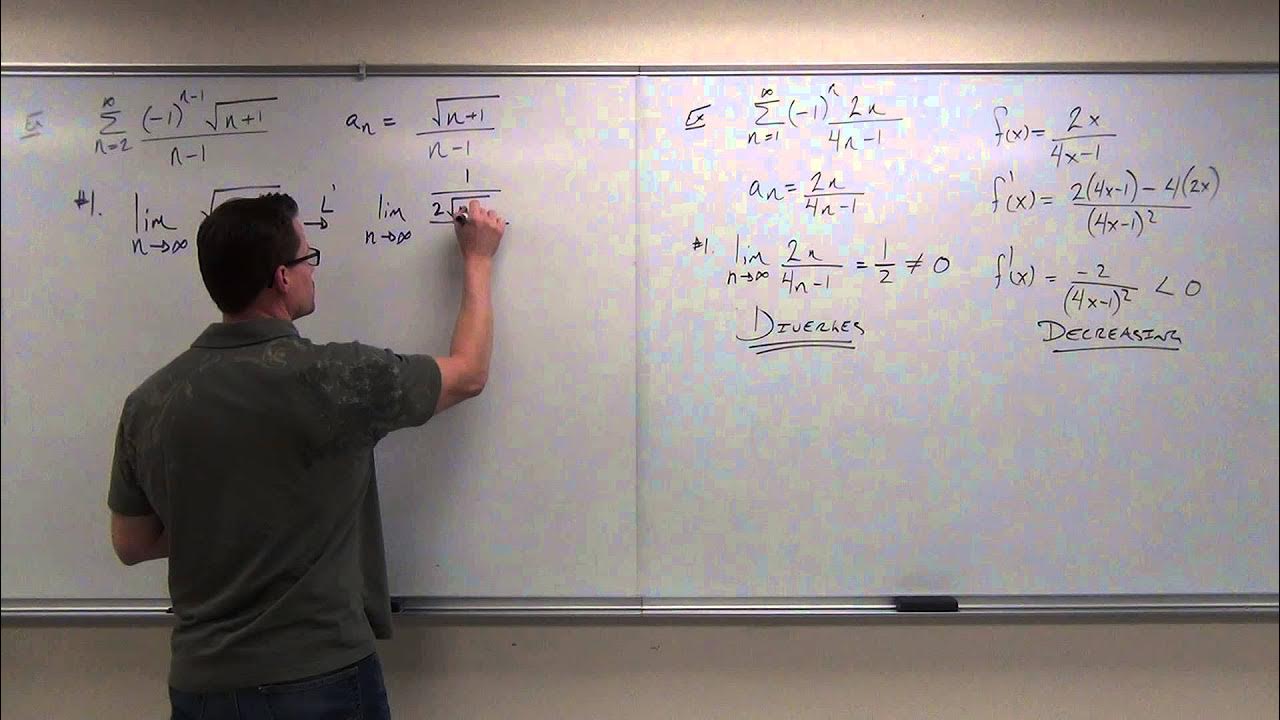Alternating Series Day 2
TLDRThe video discusses the concept of convergent alternating series, explaining how to approximate their sums and determine the error in the approximation. It demonstrates using the first four terms of a series as an example, showing how the error is less than the absolute value of the first omitted term, and how to calculate the bounds of the actual sum.
Takeaways
- 📉 Alternating series must be alternating, decreasing in magnitude, and the limit as n approaches infinity must go to zero for convergence.
- 🔍 The error in approximating the sum of a convergent alternating series is always less than the absolute value of the first omitted term.
- 🔢 To approximate the sum of an alternating series, you sum the first few terms as specified.
- 📏 The error is the absolute value of the actual sum minus the approximated sum and can be bounded by the next term in the series.
- ✔️ If you approximate using the first four terms, the error is less than the absolute value of the fifth term.
- 🔗 The error bounds the actual sum within a range defined by the approximation plus or minus the error.
- 📊 For an error less than a specified value, determine the term where the next omitted term is smaller than the desired error.
- 🧮 Finding the appropriate number of terms can be done through a process of checking when the first omitted term's value is less than the desired error threshold.
- 📈 Using examples, like approximating a given series, helps in understanding the application of these error bounds.
- 🤔 Understanding the relationship between denominators and error size is crucial: larger denominators mean smaller errors.
Q & A
What is a convergent alternating series?
-A convergent alternating series is a series where the terms alternate in sign and the absolute value of the terms decreases towards zero as the series progresses. The series converges to a certain value, meaning the sum of its terms approaches a finite limit.
What are the conditions for an alternating series to converge?
-For an alternating series to converge, it must be alternating in sign, the absolute values of the terms must be decreasing, and the limit of the terms as n approaches infinity must be zero.
How can we approximate the sum of a convergent alternating series?
-We can approximate the sum of a convergent alternating series by summing a finite number of its initial terms. The more terms we include, the closer our approximation will be to the actual sum.
What is the error in an approximation of a convergent alternating series?
-The error in an approximation is the absolute value of the difference between the actual sum of the series and the sum of the partial series used for the approximation. It is always less than the absolute value of the first omitted term.
How do we calculate the error in the approximation of a convergent alternating series?
-The error in the approximation is less than the absolute value of the next term in the series after the last term included in the approximation. This is because the series is decreasing in magnitude.
What is the example series discussed in the script?
-The example series discussed in the script is a convergent alternating series with terms involving powers of -1 and factorials in the denominator, starting from 1/(1!), -1/(2!), 1/(3!), and so on.
How many terms were used in the example to approximate the sum of the series?
-In the example provided, the first four terms of the series were used to approximate the sum.
What was the approximate sum calculated using the first four terms of the series?
-The approximate sum calculated using the first four terms was 15/24, which simplifies to 625/24.
How was the error in the approximation justified in the example?
-The error in the approximation was justified by showing that it is less than the absolute value of the first omitted term, which in this case was 1/(5!) or 1/120.
What is the maximum error allowed if we want the approximation to be within 1/1000 of the actual sum?
-To ensure the approximation is within 1/1000 of the actual sum, the first omitted term must be less than 1/1000. This requires determining the smallest n such that 1/(n^4) is less than 1/1000.
How many terms are needed to ensure the error is less than 1/1000 in the approximation?
-At least six terms are needed to ensure that the first omitted term is less than 1/1000, as 6^4 is greater than 1000.
Outlines
📚 Understanding Convergent Alternating Series Approximation
This paragraph introduces the concept of approximating the sum of a convergent alternating series. It explains the conditions for an alternating series to converge: it must alternate in sign, decrease in magnitude, and have a limit of zero as 'n' approaches infinity. The paragraph details how to approximate the sum using a partial sum and how to calculate the error of this approximation, which is always less than the absolute value of the first omitted term. An example is given, where the first four terms of a series are used to approximate the sum, resulting in an approximation of 625 with an error less than 1/100. The error is calculated using the first omitted term, which in this case is the fifth term, and is shown to be less than 1/120. This provides a range within which the actual sum must lie, demonstrating the approximation's accuracy.
🔍 Determining Terms for a Specified Error in Alternating Series
The second paragraph focuses on how to determine the number of terms needed in an alternating series to ensure that the approximation error is less than a specified value, in this case, 1/1000. It explains the error bound for an alternating series, which is the absolute value of the first omitted term. The speaker guides through a process of trial and error to find the smallest 'n' such that the nth term is less than 1/1000. By calculating the fourth power of increasing natural numbers, it is determined that the sixth term is the first to meet the condition, meaning at least five terms are needed for the approximation error to be within the desired limit. The paragraph concludes with a brief mention of a worksheet and an anticipation of a follow-up session.
Mindmap
Keywords
💡Convergent Alternating Series
💡Approximation
💡Error Statement
💡Partial Sum
💡Magnitude
💡Limit
💡Omitted Term
💡Factorial
💡Denominator
💡Guess and Check
Highlights
Introduction to the topic of convergent alternating series and the importance of approximation with an error statement.
Conditions for an alternating series to converge: it must be alternating, decreasing in magnitude, and the limit as n approaches infinity must be zero.
Approximation of a convergent series by using partial sums and the concept of error in approximation.
The error in approximation is always less than the absolute value of the first omitted term.
Demonstration of how to calculate the error by determining the next term in the series.
Example of approximating a known convergent alternating series using the first four terms.
Calculation of the approximation sum using the first four terms of the series.
Explanation of the error calculation for the approximation, using the fifth term as the first omitted term.
Derivation of the error bound, showing that the approximation is within a certain range of the actual sum.
Use of a calculator to find the smallest and largest possible values of the sum within the error bounds.
Clarification that the sum cannot be a certain value (0.7 in this case) based on the error bounds.
Discussion on how to determine the number of terms needed for a desired error threshold.
Process of finding when the first omitted term will be less than a specific threshold (1/1000).
Conclusion on the ease of creating an error statement for an approximation of a convergent alternating series.
Announcement of a worksheet and a follow-up session for further exploration of the topic.
Transcripts
Browse More Related Video

AP Calculus BC Lesson 10.10

Alternating series remainder | Series | AP Calculus BC | Khan Academy

Alternating Series Error Bound

Calculus BC – 10.10 Alternating Series Error Bound

Alternating Series Test and Error for Alternating Series

Calculus 2 Lecture 9.5: Showing Convergence With the Alternating Series Test, Finding Error of Sums
5.0 / 5 (0 votes)
Thanks for rating: